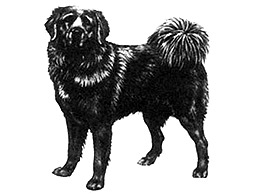Breed standards
Tibetan Mastiff
Breed standards are the official guidelines that describe the ideal characteristics, temperament, and appearance of a breed and ensures that the breed is fit for function with soundness essential.

Kennel Club, London 1994
Large, powerfully built, slightly longer than high. Well boned and muscled, never light but always agile. Impressive head provides a noble, dignified look, enhanced by a mane, which is more pronounced in males, balanced by a well feathered tail carried over the back.
A loyal companion and guardian. Slow to mature.
Independently minded, aloof and protective. Calm and patient. May be wary of strangers.
Broad, heavy and strong. Skull large, with strongly defined occiput and marked stop. Length from nose to stop equal or slightly less than length from stop to occiput. Muzzle fairly broad, well filled, blunt, and square viewed from all sides. Broad, black nose, well open nostrils. Lips well developed with moderate flews. In maturity, some wrinkling on head extending from above the eyes to thee corner of the mouth.
Very expressive, medium size, dark brown. Set well apart, oval and slightly slanting. Dark, close fitting eye rims.
Medium size, triangular, pendent, not set too low, hanging close to the head. When alert, carried forward. Ear leathers covered with soft, short hair.
Jaws strong with perfect, regular and complete scissor bite. i.e. upper teeth closely overlapping lower teeth and set square to the jaws. Level bite acceptable. Full dentition desirable.
Strong, well muscled, slightly arched. Not too much dewlap.
Muscular, well laid shoulders. Strongly boned, straight legs with strong, slightly sloping pasterns.
From point of shoulder to point of buttock slightly longer than height at withers, as is 10 to 9. Strong and straight back. Broad, muscular loins, with very slightly sloping croup. Chest rather deep, of moderate breadth. Ribcage oval ribs well sprung but not barrelled carried well back. Brisket reaching to, or just below, elbows.
Powerful, muscular, with moderate angulation and strong, low set hocks. Hind legs, seen from behind, parallel. Single or double dewclaws may be present.
Fairly large, strong, with thick pads, rounded and compact. Having good feathering between toes.
Medium to long. Set on high. Loosely curled over back to one side. Well feathered.
Powerful and free, with purpose and agility. Measured and deliberate when walking. At speed will tend to single track.
Males carry noticeably more than females. Quality of greater importance than quantity. Densely coated, fairly long, thick, with heavy, woolly undercoat in cold weather, which becomes rather sparse in warmer months. Hair fine, hard and straight, never silky, curly, or wavy. Hair on face short. Neck and shoulders heavily coated, giving mane-like appearance. Tail heavily feathered, hind legs well feathered on upper rear parts.
Rich black, with or without tan, slate grey, with or without tan, rich golden. The rich tan markings appear above the eyes, on muzzle, on chest, the lower part of legs and underside of tail. Spectacle markings around the eyes acceptable. White star on breast permissible. Minimal white markings on feet tolerated. Cream, white, chocolate/liver, particolour, brindle or flecked are undesirable.
A minimum height of 66 cms (26 ins) in dogs and 61 cms (24 ins) in bitches desirable, but on no account should type be sacrificed to size alone.
Any departure from the foregoing points should be considered a fault and the seriousness with which the fault should be regarded should be in exact proportion to its degree and its effect upon the health and welfare of the dog.
Male animals should have two apparently normal testicles fully descended into the scrotum.



